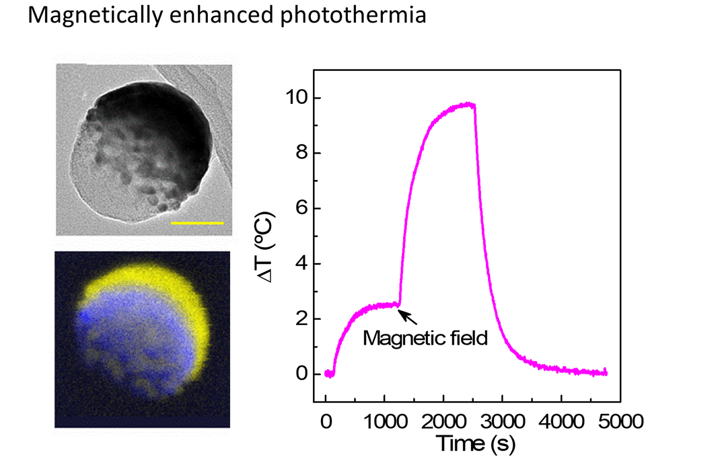Video Article Open Access
Magnetoplasmonic Nanodomes as A Novel Structure for Biomedical Applications
J. Nogués1,*, Z. Li1, A. Aranda-Ramos2, A. López-Ortega3, P. Güell-Grau1, J.L. Tajada1, L. Pou-Macayo2, F. Pi2, S. Lope Piedrafita2, A.G. Roca1, M.D. Baró2, J. Sort2, P. Vavasori3, C. Nogués2, B. Sepúlveda1
1Catalan Institute of Nanoscience and Nanotechnology (ICN2), Barcelona, Spain
2Universitat Autònoma de Barcelona, Bellaterra, Barcelona, Spain
3CIC nanoGUNE, Donostia-San Sebastian, Spain
Vid. Proc. Adv. Mater., Volume 2, Article ID 2108212 (2021)
DOI: 10.5185/vpoam.2021.08212
Publication Date (Web): 25 May 2022
Copyright © IAAM
Graphical Abstract

Abstract
Advanced nanobiomedical applications have been traditionally based on chemically synthesized inorganic nanoparticles. Here we present a novel type of structure especially suited for diverse biomedical uses: magnetoplasmonic nanodomes [1,2]. The nanodomes are composed of a combined, magnetic and plasmonic, hemispherical shell deposited onto 100 nm diameter polystyrene beads. The variation of the materials and their thicknesses in the shell enables tuning both the optical and magnetic properties of the nanostructures. The very high plasmonic absorption of the nanodomes in the near-infrared is used for very efficient local optical heating, i.e., photo-hyperthermia for cancer treatment [1]. The nanodomes magnetic character allows to remotely manipulate them to easily regulate the level of photo-hyperthermia. Moreover, given their asymmetric shape they exhibit strong optic and magnetic anisotropies. Thus, the rotation of the nanodomes using alternating magnetic fields can easily tracked optically using their different absorption depending on the orientation. Since the rotation of the nanoparticles depends strongly on the viscosity of the medium, which in turn depends on the temperature, the optical tracking of the rotation can be used to accurately determine the local temperature around the nanodomes, i.e., nanothermometry [2]. Combining the nanodomes efficient photo-hyperthermia with their nanothermometry capabilities, allows in-situ tracking the efficiency of photo-hyperthermia treatments.
Keywords
Magnetoplasmonic materials; hyperthermia; nanothermometry.
Acknowledgement
We acknowledge the funding of the Spanish Ministry of Science and Innovation (PID2019-106229RB-I00 and RTI2018-095495-J-I00 projects) and the Ramón Areces foundation (MAGPLADRUG project).
References
- Z. Li et al., Applied Materials Today, 2018, 12, 430.
- Z. Li et al., Small 2018, 14, 1800868.
Biography
Josep Nogués, ICREA Research Professor earned his degree from the Universitat Autònoma de Barcelona (Spain) in 1986. After obtaining his PhD at the Kungliga Tekniska Höskolan in Stockholm (Sweden) in 1993, he moved to the University of California San Diego (USA) to complete his postdoctoral studies. Four years later he returned to the Universitat Autònoma de Barcelona as an associate researcher, becoming an ICREA research professor in 2001. He is since 2006 the group leader of the Magnetic Nanostructures group at the Catalan Institute of Nanoscience and Nanotechnology (ICN2; Barcelona, Spain). Prof. Nogués has published 252 articles (including eight reviews), with over 18,500 citations and an H-index of 59. He is the author of five patents and his work has given rise to over 245 invited talks at international conferences and workshops.
Video Proceedings of Advanced Materials

Upcoming Congress



